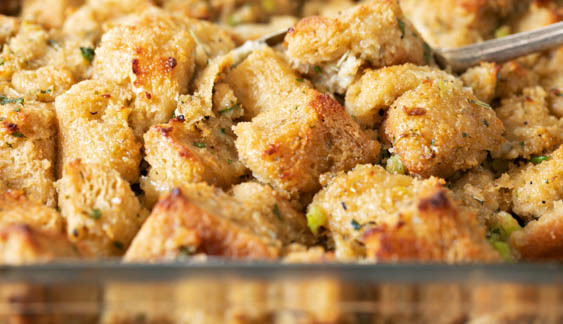Light and Crisp Thanksgiving Bread Stuffing

introduction
Thanksgiving bread stuffing can be a real gut bomb. We’ve produced a few and consumed a-many. This year, our holiday recipe review, conducted internally, drew us to a stunningly obvious conclusion: bread stuffing doesn’t need a bunch of eggs, or any milk or cream at all. What it needs is outstanding bread, homemade stock, and honest aromatics—not a whole lot more. Yes, the bread is stale . . . so it can become moist with deliciousness as it bakes. But good bread is good bread stale. And bad bread doesn’t improve with onions, poultry seasoning, or boxed chicken broth. So we started with really great bread: the Japanese milk bread that baker Henry Jones developed for Anson Mills. It’s a straight yeasted dough, long on the rise but short on labor, with a fine, rich crumb. Not as eggy and airy as brioche and not chewy-dense like a country boule, either. We dumped the sausage, the mushrooms, the nutmeats, and kept the moistening agents light and clean.
This stuffing is wondrously light and delicately seasoned, with crisp, buttery contours and a moist center.
Cooking Remarks
We have a quarter-cup range for the volume of broth in this recipe. Your preference for a stuffing’s interior consistency—from creamy-damp to dryishly moist—and whether or not you plan to reheat it (or think you might) will determine which amount you choose. Frankly, as the stuffing cools, its interior dries somewhat. Since most Thanksgiving gatherings don’t serve stuffing piping hot, the larger volume is perhaps the better choice. In any case, the soaked bread cubes should be just saturated but not dripping. Start on the lower range of liquid (a bit less egg won’t matter) and proceed at will.
We love the flavor of herbes de Provence in this stuffing—it pairs beautifully with the shallots, which, themselves, accent the flavor of the bread most delicately. Dried rosemary leaves may prove a distraction, however, so the recipe suggests grinding the mix in a spice grinder. If you prefer more traditional herbs, feel free to substitute 2 teaspoons each of chopped fresh sage and chopped fresh thyme for the dried herbs.
The stuffing bakes on a pizza stone or baking steel to crisp the bottom of the bread. While not entirely crucial, we highly recommend it.
equipment mise en place
For this recipe, you will need a digital kitchen scale, a pizza stone or baking steel, a rimmed baking sheet, a large bowl, an 8-inch square glass or ceramic baking dish, a 10-inch skillet, a 1-quart liquid measuring cup, a whisk, parchment paper, aluminum foil, a small saucepan, and a pastry brush.
-
-
1day-old loaf Japanese Milk Bread, baked in a Pullman loaf pan or a Dutch oven
-
3tablespoons unsalted butter, plus additional for the baking dish
-
2 or 3shallots, minced (⅓ cup)
-
1celery rib, minced (¼ cup)
-
1teaspoon herbes de Provence, ground to powder in a spice grinder, or 2 teaspoons each chopped fresh sage and thyme
-
1teaspoon minced garlic
-
2tablespoons minced fresh flat-leaf parsley
-
Scant 1 teaspoon sea salt
-
½teaspoon freshly ground black pepper
-
1.5ounces beaten egg (from 1 large egg)
-
1½ to 1¾cups Rich Homemade Chicken Stock or Ultimate Vegetable Stock, room temperature
-
-
Adjust the oven racks to the lower- and upper-middle positions. Slide a pizza stone or baking steel onto the lower rack and heat the oven to 200 degrees. Trim the bread of its crust, then cut the loaf into ½-inch slices. Cut each slice into ½-cubes. You will need 1 pound of bread cubes (about 10 cups). Turn the bread onto a rimmed baking sheet and dry it in the oven for 1 hour, stirring once about halfway through.
-
Turn the bread into a large bowl. Increase the oven temperature to 350 degrees. Butter an 8-inch square glass or ceramic baking dish and set it aside.
-
In a 10-inch skillet, warm 1½ tablespoons of the butter over low heat until it foams. Add the shallots and cook, stirring frequently, until translucent, about 1 minute. Stir in the celery and sauté until tender, about 2 minutes. Stir in the garlic, followed by the herbes de Provence, parsley, salt, and pepper. Remove the skillet from the heat and let cool until barely warm.
-
In 1-quart liquid measuring cup, whisk together the egg and stock, then stir in the sautéed vegetables. Pour the mixture into the bowl with the bread and toss lightly with your hands until the bread is evenly moistened. Transfer to the prepared baking dish and pat into place. Cover flush with parchment paper, then cover tightly with aluminum foil. Slide the dish onto the pizza stone or steel and bake for 30 minutes.
-
Remove the baking dish from the oven and remove the foil and parchment. Slide the dish onto to the upper rack and continue to bake until the surface is golden and the edges deepen in color, about 10 minutes. Meanwhile, in a small saucepan, melt the remaining 1½ tablespoons butter over low heat, then set aside. When the stuffing is done, remove it from the oven and brush the top with the melted butter. Serve warm.